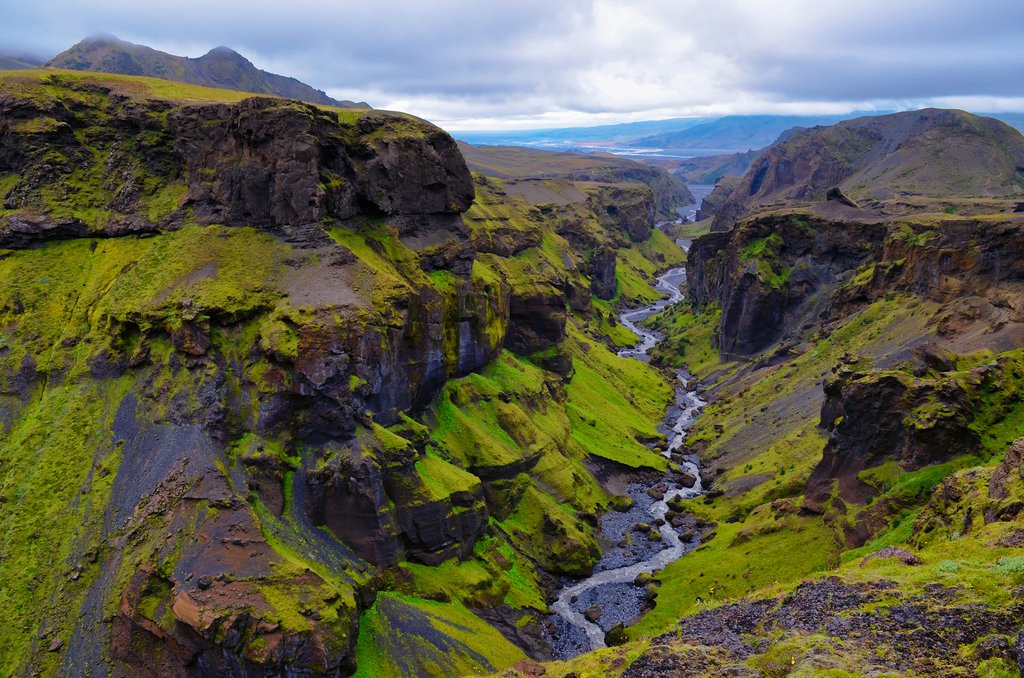Weather
September is a lovely time to visit Iceland as the lush greens of the summer give way to the burnt colors of the Arctic foliage. The mercury begins to drop, and the rains start to increase, especially along the southern and western coasts, and the warming Gulf Stream makes September a fine time for swimming and surfing (if you can handle a water temp of 50 degrees).
Temps across the country range between 41-50 degrees Fahrenheit, with the highlands and northern Iceland being a little cooler and drier—though it wouldn’t be Iceland without a sudden snow shower.
The Northern Lights start to make their first appearances as the days shorten from 15 hours of daylight to just over 11 by the end of the month. As the popular saying goes, “There is no bad weather, only bad dressing,” you’ll want to pack accordingly: layers, thermals, and all your waterproof gear.
Crowds & Costs
With the start of the shoulder season, September is a great alternative to the summer months if you want to skip the crowds. You can find lowered rates for flights, hotels, and car rentals, more availability for accommodations, and enough daylight hours for enjoying outdoor activities and sightseeing. The weather, too, is still warm enough to encourage plenty of outdoor activities, including swimming.
Chat with a local specialist who can help organize your trip.
Where to Go
This is a great time to explore Iceland’s best-loved gems after the peak crowds have left, and there's not a region in the country that doesn't offer plenty to do. Most travelers will either start or end their trip with a few days in or around Reykjavík. Home to design-forward architecture, cool boutiques, trendy restaurants, and plenty of Viking lore, the capital is a great jumping off point to popular attractions in the Reykjanes Peninsula, like the Golden Circle and South Shore.
While on the southwest coast consider a trip to the town of Vestmannaeyjar on Heimaey island, if not for its remote and geographical beauty, then for the colorful nesting puffins. And now that the road conditions are more favorable, return to the mainland and continue along the Ring Road to Akureyri, the capital of Northern Iceland, and another access point to notable sites, including Lake Mývatn for your choice of volcanoes, geothermal hot springs, caves, and lava fields.
If following the Ring Road, a trip to Húsavík on Skjálfandi Bay in north Iceland should not be missed before carrying on clockwise around the island. Go at your own pace stopping periodically to explore the island’s highlights, like Dettifoss, Europe’s most powerful waterfall, Seyðisfjörður on the innermost point of an east coast fjord, and Höfn to stretch the legs, have a cocktail and admire views on Ósland from the Seaman’s Monument.
Bear in mind the Highlands in mid-September close for the offseason.
What to Do
With the late summer weather, there are still many things to do in Iceland. Explore cities like Reykjavík, Akureyri, Kópavogur, Hafnarfjörður, Siglufjörður, and Húsavík for the best museums, restaurants, and drool-worthy natural attractions. Rent a car or join a tour to get into the countryside and discover coastal villages along rugged fjords and fairytale-esque turf houses and churches.
Sporty types should consider a rafting excursion on the Hvítá River in the Gulfoss Canyon and hiking in Þórsmörk on the stunning Fimmvörðuháls trail or do a combination of hiking and camping in Þríhyrningur in the country’s southwest. For a truly unique experience, slip into a drysuit and brave the cold Lángjökull glacial waters of the Silfra fissure in Þingvellir National Park where you can snorkel or scuba dive between (and touch!) the North American and Eurasian tectonic plates.
Join a whale watching tour in Faxaflói Bay or head north to Dalvík or Húsavík to seek out one or two of the many species of gentle giants. And now that the nights are growing noticeably longer, September marks the start of the Northern Lights season. Hop in your rental or join a tour (bus, Super Jeep, or boat) and move away from artificial light pollution for better visibility of the Auroras.
Other popular outdoor activities for this month include two of Iceland’s oldest traditions: Berjamó and Réttir. Join natives as they go to Berjamó, that is head out into nature to pick berries, like wild crowberries that grow in moss-covered lava, bilberries, and blueberries too. At the same time, throughout the country farmers and their friends participate in Réttir for the annual sheep and horse round-up.
Events in September
Réttir. Literally meaning “round-up,” is just that: the time of year when thousands of sheep and wild horses are rounded up for winter.
Reykjavík Jazz Festival. A five-day jazz festival in early September with performances of traditional and contemporary jazz in a slew of venues around the Icelandic capital. Seasoned (international) stars as well as up-and-coming local artist play.
Reykjavík International Literary Festival. Now a UNESCO-recognized city of literature, this biannual event hosts acclaimed authors where you can attend readings and seminars, and dance the night away at the Literary Ball shoulder-to-shoulder with your favorite authors.
Reykjavík International Film Festival (RIFF). A non-profit 11-day event hosted by the capital is the country’s largest and culturally diverse fête. Featuring new and progressive quality films, panel discussions and workshops, as well as concerts and exhibitions, the festival highlights independent filmmaking from around the world.
More Helpful Information
Iceland in August
Iceland in October
Best Time to Visit Iceland
More Iceland Itinerary Ideas
